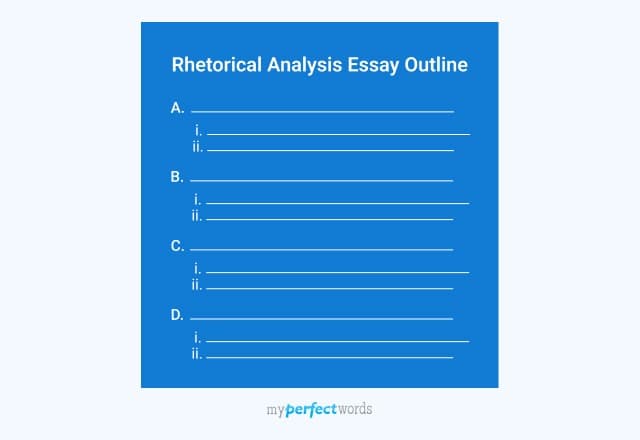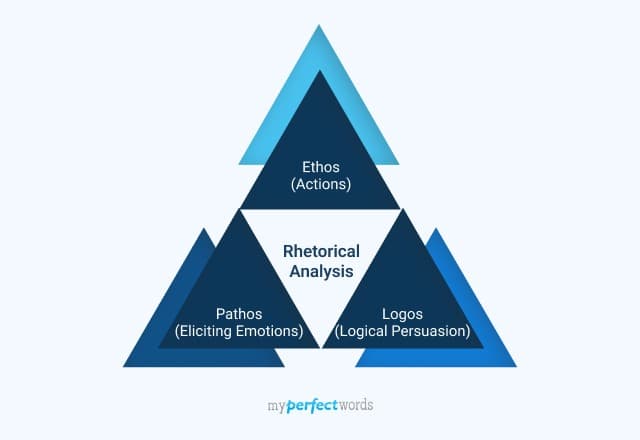
Have you ever stared at a blank page, wondering how to begin your rhetorical analysis essay?
You're not alone. Many students find the first step, creating an outline, to be a challenge.
The truth is - tackling a rhetorical analysis without a well-structured outline can lead to confusion and disorganization. But fear not because there's a solution.
In this blog, we will show you how you can create a rhetorical analysis essay outline. By the end, you’ll have a thorough understanding of what your outline should look like.
So, keep reading to find out how you can beat the blank pages!
On This Page![]()
- 1. What Is Rhetorical Analysis Essay?
- 2. Why Create a Rhetorical Analysis Essay Outline?
- 3. Components of a Rhetorical Analysis Outline
- 4. Steps to Create a Rhetorical Analysis Essay Outline
- 5. Rhetorical Analysis Essay Outline Examples
What Is Rhetorical Analysis Essay?
A rhetorical analysis essay is a type of analytical essay that examines how an author uses language and persuasion to get their message across.
It involves analyzing speeches or essays to understand how authors use strategies within the rhetorical triangle to influence their intended audience. These techniques usually involve logical appeal, moral argument, and vivid imagery that appeals to the listener.
Key Elements to Analyze
In a rhetorical analysis essay, you would be analyzing the text keeping these key rhetorical concepts in mind:
- Ethos: This concerns the credibility of the author or speaker.
- Logos: This focuses on the logical aspects of the argument.
- Pathos: Pathos explores the emotional appeal of the discourse.
- Style and Tone: This involves analyzing the author's writing style and the overall tone of the text.
These elements provide a structured approach to rhetorical analysis, revealing how effective communication is achieved.
Why Create a Rhetorical Analysis Essay Outline?
Writing a rhetorical analysis essay requires a writer to draft a structured piece of writing. This essay type is one of the most challenging tasks students are assigned to do for their academics.
Apart from conducting a strong analysis, a rhetorical analysis essay depends on how perfectly the essay outline is drafted.
An outline organizes the raw information and makes it understandable for the readers. It serves as your compass, ensuring you stay on course throughout the rhetoric essay. It helps you structure your ideas and arguments, adding clarity to your essay writing process.
Moreover, an outline works as a checklist for your essay. It assures you that nothing important is missed in the content.
Components of a Rhetorical Analysis Outline
Now that we've explored why creating an essay outline is essential, it's important to explore the different components of a rhetorical analysis outline.
Here’s a detailed rhetorical analysis essay outline:
I. Introduction II. Rhetorical Situation Analysis III. Rhetorical Strategies IV. Analysis of Rhetorical Devices V. Evaluation of Effectiveness VI. Conclusion |
Each element plays a crucial role in crafting a well-structured and persuasive analysis, so let's explore them in detail:
Introduction
The introduction of your rhetorical analysis essay serves as the gateway to your analysis. It's where you captivate your reader's interest, provide essential background information, and present your thesis statement.
Here are the elements typically included in an introduction paragraph:
- Hook
The "hook" is a sentence or two designed to grab the reader's attention. It could be a thought-provoking quote, a surprising fact, or a compelling question. The purpose is to make your reader interested in what you're about to discuss—how an author uses rhetorical devices. - Background Information
After the hook, provide some context. Here, you briefly introduce the text you're analyzing, the author or speaker, and the overall topic. It's like giving your reader a map to navigate through your analysis. - Thesis Statement
The thesis statement is the main argument, your "claim." This concise sentence outlines what you'll be analyzing and what your main points will be. Your thesis should tell the reader what to expect in your analysis.
Body
The body of your essay is where you dissect the author's persuasive techniques and reveal their impact on the audience. It contains sections dedicated to each rhetorical strategy you're examining.
In these sections, you'll explain the strategies, provide evidence from the text, and offer your insightful analysis of their effectiveness.
Section for Each Rhetorical Strategy
In the body paragraphs, you'll have sections dedicated to each rhetorical strategy you're analyzing. These sections each will focus on a different aspect of the text. For each strategy, you'll do three things:
- Explanation of the Strategy
Start by explaining what the rhetorical technique is. Define it clearly for your reader. This is like providing a dictionary definition. - Examples from the Text
Next, provide examples from the text you're analyzing. These are specific quotes or passages where the author or speaker uses the strategy you're discussing. It's like showing your reader the evidence. - Analysis of the Effectiveness
Finally, analyze how effective the strategy is. This is where you dive deep into the text and explain how and why the strategy persuades the audience.
Conclusion
The conclusion should leave your readers with a sense of closure and a clear understanding of your analysis.
You don't introduce new information or arguments in this section; instead, you tie everything together. Here are the three essential elements of an impactful essay conclusion:
- Restate Thesis
Start by restating your thesis to remind readers of your main argument. Repeating your main argument clearly helps the reader tie in all they have read in your essay. - Summarize Main Points
Summarize the main points from each section of your analysis. This serves as a reminder of the highlights of your arguments made throughout the essay. - Final Thoughts
Conclude by sharing your thoughts on how the author's strategies affect the audience and the text's broader importance. Encourage readers to consider these strategies' impact and the text's relevance.
This structure in your rhetorical analysis outline ensures that your analysis is clear, well-organized, and persuasive. Each component plays a crucial role in guiding your reader through your analysis.
Steps to Create a Rhetorical Analysis Essay Outline
Creating an essay outline is a crucial step in organizing your thoughts and effectively analyzing a piece of rhetoric. Here are the steps to craft an outline for a rhetorical analysis essay:
Step 1 - Choose the Text
Select the piece of rhetoric that you will be analyzing. It could be a speech, a written essay, an advertisement, a political campaign, or any other form of communication.
Step 2 - Identify Rhetorical Devices and Rhetorical Appeals
Look for rhetorical devices such as metaphor, simile, analogy, hyperbole, and alliteration. Analyze how these devices contribute to the message. Identify any repetition, parallelism, or rhetorical questions used in the text.
Moreover, look for common rhetorical appeals i,e., ethos, pathos, and logos.
Step 3 - Analyze Appeals and Strategies in Each Section
For each argument, dedicate a body paragraph that will analyze how the author/speaker uses ethos, pathos, and logos.
Note the specific rhetorical devices used in each section and their impact.
Step 4 - Consider the Effect on the Audience
While outlining the last body paragraph, add points that analyze how the appeals are intended to affect the audience.
Consider whether the author/speaker is trying to persuade, inform, entertain, or provoke a specific emotional response. Include specific examples and quotations from the text to support your analysis.
Step 5 - Filter Out Extra Information
It's important to know what parts of the arguments should be included and which should be filtered out.
After having a sketch of the introduction and body paragraphs, remove any information that might feel irrelevant.
Step 6 - Conclude and Summarize
For the ending, make sure to restate your thesis statement. Include points that directly support your arguments and sum up your analysis.
These steps help you plan your essay for a well-structured, clear, and cohesive essay.
Here's a sample rhetorical analysis essay outline template that analyzes ethos, pathos and logos:
I. Introduction II. Ethos Analysis III. Logos Analysis IV. Pathos Analysis V. Style and Tone Analysis VI. Conclusion VIII. References |
Here’s a practice outline:
Rhetorical Analysis Essay Outline Examples
Here are some rhetorical analysis essay outline pdf that you can use as reference outlines:
Need more help getting started? Check out these expert rhetorical analysis essay examples to get inspired!
In conclusion, you've got the tools and examples you need to ace your rhetorical analysis essay. The steps we've gone through provide a strong starting point for your academic journey into analyzing persuasive writing.
But if you ever hit a wall or need help with tight deadlines, don't forget our experts are here to lend a helping hand. Our essay writing service for college has helped lots of students like you get top-notch essays.
So, why wait? Place your order now and set yourself up for academic success!

Write Essay Within 60 Seconds!
Use our AI tool to generate high quality essay
WRITTEN BY
Nova A.
Nova Allison is a Digital Content Strategist with over eight years of experience. Nova has also worked as a technical and scientific writer. She is majorly involved in developing and reviewing online content plans that engage and resonate with audiences. Nova has a passion for writing that engages and informs her readers.




